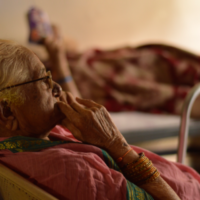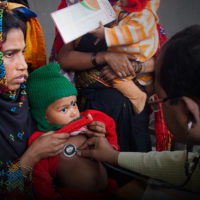When an off road jeep pulled up to pick me up for my visit to GRAVIS, I was instantly excited; as I knew it meant we would be heading right into the desert to see the real issues that GRAVIS is trying to overcome. Two hours later and we were still on the road, heading deeper into the desert. It was becoming difficult for me to understand how people could survive in these conditions – the heat was unforgiving, with no shade and an empty landscape of never ending sand.
Our first stop was a school. The organisation has been keen to highlight the importance of education as it is not an immediate priority for villagers in the Thar, with the drop-out rate being incredibly high. All their schools are thus open to both sexes – to combat the stigma of girls going to school. Not only is the region well below the national average for literacy but shockingly only 10% of women are literate. In addition to cultural challenges, there is also the practical issue of travelling to school as many children live isolated in small huts. GRAVIS currently runs more than 20 primary schools, whose end goal is to be governed by the state so that sustainability can be maintained. The school I visited consisted of 4 classrooms and a non-formal education class which was being taught outside, under a shelter. The children in the classrooms were seated cross-legged and they filled the classrooms wall to wall, all eagerly listening to the one teacher and looking up at the blackboard. They were keen to show off their talents to me and joyfully recited the alphabet, songs and poems.
Later, I headed to the Gagadi field centre which is the organisation’s flagship complex. It consists of a primary school, training facilities, accommodation, cattle farming and a kitchen. After sharing lunch with the staff members, I headed to another village to understand the importance of agriculture in the area better. I was taken to a large, fenced off piece of land and learnt that GRAVIS sets up plots such as these all over the region; in order to cultivate the barren land to grow crops for cattle to feed on. The sustainable management of natural resources is of vital importance for GRAVIS especially due to rising populations, falling water tables and accumulating droughts. GRAVIS encourages the villagers to stick with traditional farming methods and has conducted research so they are aware of the most compatible farming methods to tackle the challenges posed by the harsh desert environment.
Water security is a constant struggle for villagers in the Thar, which receives an average rainfall of less than 200mm. The most common way that GRAVIS tries to overcome this problem is by building tankaas, which are large underground water tanks. These tanks have a catchment area, a slope into the tank filters out silt and sand, and a mesh over the well prevents animals from falling in. So far, GRAVIS has installed approximately 5,000 tanks which each hold 20,000 litres of water. During my visit, I was taken to a village which has a tankaa in place. One family demonstrated how they use it, pulling water out with a bucket on a rope. The tankaas serve many families and communities have formed around them, forming a central hub.
The last agenda for my visit was to attend a Village Development Committee meeting in Jelu village. Attended by the villagers themselves, these meetings are held every month and serve as a forum to discuss community issues and solutions. These meetings give people ownership over their lands and enable them to come up with local solutions to the issues they face. GRAVIS members often attend these meetings or are kept informed of any issues in the area so that they can work with the community to resolve the same.
Future aims:
GRAVIS will continue its work for girl child education, and aim to deliver greater gender equality to the region. Their work began because of the harshness of the desert region and therefore in the future the NGO would look to expand to other regions of difficulty such as the Himalayas. They also hope to increase awareness about the situation in the Thar, lobbying with the government and networking with other organisations to gain increased support. Water security will continue to be of high priority. The organisation will be constructing more rainwater harvesting systems as well as aiming to popularise them by giving demonstrations on their importance. The organisation wants to better prepare itself for droughts and wishes to be able to provide emergency relief for villagers when a drought does strike.
Established in 2000, Give is the largest and most trusted giving platform in India. Our community of 2.6M+ donors have supported 2,800+ nonprofits, impacting 15M+ lives across India.
Discover more from give.do
Subscribe to get the latest posts to your email.


